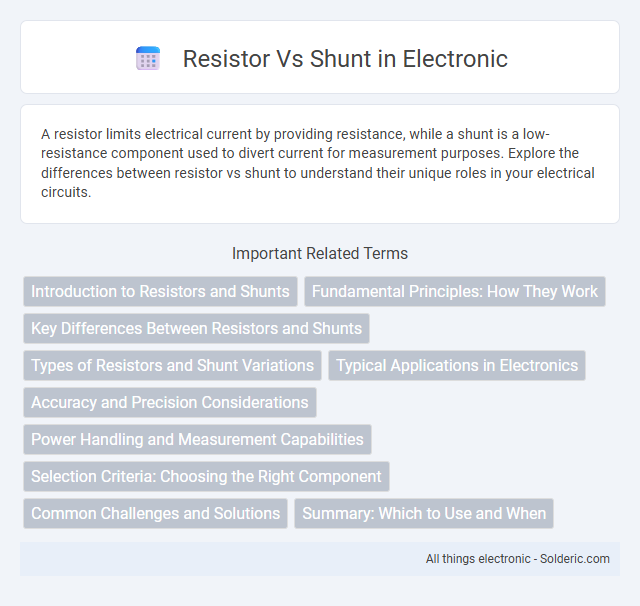A resistor limits electrical current by providing resistance, while a shunt is a low-resistance component used to divert current for measurement purposes. Explore the differences between resistor vs shunt to understand their unique roles in your electrical circuits.
Comparison Table
| Feature | Resistor | Shunt |
|---|---|---|
| Definition | Electrical component limiting current by resistance | Low-resistance device measuring current via voltage drop |
| Primary Use | Control current, divide voltage, create heat | Current sensing in ammeters and circuits |
| Resistance Value | Wide range (ohms to megaohms) | Very low (milliohms) |
| Power Dissipation | Varies; generally standard wattage ratings | High power ratings to handle large currents |
| Accuracy | Typical tolerance 1% - 10% | High precision, 0.1% or better |
| Applications | General circuit design, voltage division | Current measurement, protection circuits |
| Construction | Carbon, metal film, wirewound types | Metal strip or wire with low resistance alloy |
Introduction to Resistors and Shunts
Resistors and shunts are essential electrical components used to control current and measure electrical parameters. A resistor limits current flow and drops voltage in a circuit, while a shunt is a precision resistor designed to create a low-resistance path for accurate current measurement. Understanding the differences between resistors and shunts helps you optimize circuit performance and ensure precise monitoring of electrical systems.
Fundamental Principles: How They Work
Resistors limit electric current by converting electrical energy into heat through resistance, obeying Ohm's Law (V=IR). Shunts provide a low-resistance path, allowing current to bypass part of a circuit while enabling precise current measurement via voltage drop. Understanding these fundamental principles helps you select the ideal component for current control or sensing in electronic circuits.
Key Differences Between Resistors and Shunts
Resistors and shunts are both passive electrical components, but resistors are designed to limit current flow by providing a fixed resistance, while shunts are specialized low-resistance resistors used primarily for current measurement. The key difference lies in their application: resistors control voltage and current within circuits, whereas shunts enable accurate current sensing by creating a precise voltage drop proportional to the current. Shunts typically have much lower resistance values than standard resistors to minimize power loss and heating during current measurement.
Types of Resistors and Shunt Variations
Carbon composition, metal film, and wire-wound are common types of resistors, each varying in tolerance and temperature coefficient. Shunts, used primarily for current measurement, come in variations such as low-ohmic metal strip, foil, and manganin shunts, designed to offer minimal resistance and high accuracy. The choice between resistor types or shunt variations depends on application-specific requirements like power rating, precision, and thermal stability.
Typical Applications in Electronics
Resistors are widely used for current limiting, voltage division, and signal conditioning in electronic circuits. Shunt resistors serve as precision current sensing elements in power supplies, battery monitoring, and motor control systems due to their low resistance and minimal power loss. Both components are integral in circuit protection and accurate measurement applications.
Accuracy and Precision Considerations
Shunts offer higher precision in current measurement by providing a low-resistance path, minimizing voltage drop and heat generation. Resistors, while commonly used, can introduce more variability due to tolerance levels and temperature coefficients affecting accuracy. For your application, choosing a shunt resistor ensures more consistent and accurate current sensing compared to standard resistors.
Power Handling and Measurement Capabilities
Resistors typically handle moderate power levels, commonly up to several watts, and offer stable, precise resistance for accurate voltage drop measurements. Shunt resistors are designed specifically for high current sensing, often rated for higher power dissipation in the range of tens to hundreds of watts, enabling precise current measurement with minimal energy loss. Both components differ by their intended application, with shunts optimized for low resistance and durability under high currents and resistors focused on general-purpose power dissipation and voltage control.
Selection Criteria: Choosing the Right Component
Selecting the right component between a resistor and a shunt depends on factors like precision, power rating, and application requirements. Resistors are ideal for general-purpose voltage drop and current-limiting tasks, while shunt resistors excel in current sensing with low resistance and high accuracy. Your choice should be based on the needed tolerance, thermal stability, and measurement accuracy for optimal performance in your circuit.
Common Challenges and Solutions
Resistor vs shunt applications often face challenges like power dissipation, accuracy under varying temperatures, and size constraints. Selecting a shunt resistor with low temperature coefficient and high precision can enhance measurement reliability in current sensing. Your design benefits from balancing resistance value with thermal management to minimize errors and improve overall circuit performance.
Summary: Which to Use and When
Choose a resistor when you need precise current limiting or voltage division in low to moderate power circuits, as it offers predictable resistance and easier integration. Select a shunt resistor specifically for accurate current measurement in high-current applications, where low resistance and minimal power loss are critical. Your choice depends on the balance between measurement accuracy, power rating, and circuit design requirements.
resistor vs shunt Infographic

 solderic.com
solderic.com